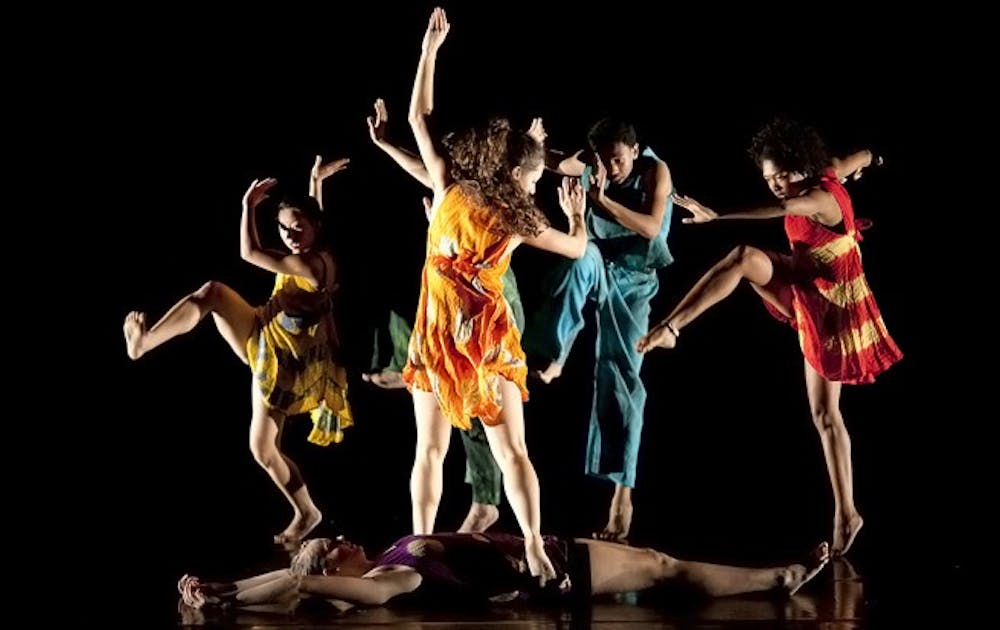Whether you’ve been a dancer at the Bolshoi or have only watched a couple episodes of Dancing with the Stars, this year’s Choreolab aims to expand, deepen and challenge your perceptions of dance, and especially dance at Duke.
This weekend, Choreolab will feature pieces that the dance department has been working on throughout the semester. These range from student-choreographed work to the culminations of the four repertory classes in the department—a high-energy African dance, a dark jazz number, a renowned neoclassical ballet and guest choreographer Nathan Trice’s modern composition.
Reflections, Choreolab’s sole ballet performance, was choreographed in the seventies by Gerald Arpino of the Joffrey Ballet and is set to Tchaikovsky’s cello piece Variations on a Rococo Theme. Before Arpino passed away in 2008, Julie Janus Walters, assistant professor of the practice, was a principal dancer under Arpino in Chicago’s Joffrey Ballet and was able to secure the rights to Reflections for the showcase.
“It’s a brilliant little fast-paced dance, and it’s always very exciting. The pace and musicality have something to do with that,” said senior Betsy Boxberger, one of the seven women in the piece. “Reflections” begins with all seven dancers on stage, and throughout the piece, each one performs a solo and a pas de deux, a duet with the piece’s only male dancer. With seven solos featured in the piece, Walters was able to guide dancers so that their solos would best showcase their individual abilities. The dancers learned the movements from two videos sent by the Joffrey Ballet, a challenging and unusual process compared to typical dance instruction. Usually, the choreography process is constantly evolving, with Walters creating and revising an original piece throughout the semester. But with Reflections, the choreography is fixed and, as dancer Rebecca Vernon noted, “everything is backwards,” meaning that if the dancer in the video moves to the left, you move to the right.
Choreolab has been a semester-long process of 90-minute rehearsals twice a week. “One of the biggest challenges is finding the energy to perform at the best of your ability during every rehearsal,” junior Kelsey Allen wrote in an email, “and as Duke students, we are constantly tired and sleep-deprived.” Moreover, Allen said, “Arpino’s work is extremely challenging. It demands technical feats en pointe while maintaining a gracefulness that makes the piece extremely beautiful aesthetically.” Despite the heavy commitment, Allen said that “the biggest reward is seeing how each of [the students] has grown in not only our technical abilities, but performance qualities throughout the semester.”
While dance enthusiasts will obviously understand the complexities and nuances of motion, Choreolab is just as accessible to newcomers. Vernon suggested audience members “look for shapes of the movement…shapes that we create in space and the feeling and fluidity of the movement.” Boxberger advises keeping an eye out for “how much the torsos move, as it is not classic to ballet…you don’t see flowery arms.”
In addition to Reflections, seven other pieces will be featured in Choreolab, including the student-choreographed solo “Glen to Glen,” the African dance numbers “Orange Again” and “Jalidon,” as well as a piece that was created in “Performance and Technology,” a class taught by Thomas DeFrantz, professor of African American Studies, Dance and Theater Studies.
DeFrantz is a first-time repertory choreographer for Choreolab. He and his students have been working on “a devised work” entitled are you still busy being mad at me? Defrantz wrote in an email that “the students developed the choreography and the stories that are at the heart of the work,” teasing that the intermission performance will involve robotic birds, which exemplifies the very interdisciplinary theme of his course.
DeFrantz went on to say that this work “involves the audience in direct address—your presence helps us tell the story of the dance, and some of you will need to come onstage in order to finish the story.”
Instructor Nina Wheeler choreographed the jazz work, Prima Facie, which features 16 student dancers. In addition, Professors Andrea E. Woods Valdes and Ava LaVonne Vinesett worked on the African dance pieces, and visiting professor Nathan Trice’s Road, Compass, Fuel explores how dancers interpret the life cycle. Trice has toured domestically and internationally with his company nathantrice/RITUALS and is an accomplished dancer, working with companies such as Complexions Contemporary Ballet and Forces of Nature Dance Theater, among others. Choreolab also features original choreography and solo performances by Duke seniors Jamie Forrest and Sarah McCaffery, the latter of whom was selected to dance at the American College Dance Festival.
With so many styles and abilities showcased through Choreolab, Vernon was apt in saying that this weekend will present “a broad spectrum of dance.”
Choreolab runs Mar. 29 and 30 at 8 p.m. in Reynolds Industries Theater. Tickets are $5 for students and can be purchased at tickets.duke.edu.
Get The Chronicle straight to your inbox
Signup for our weekly newsletter. Cancel at any time.

